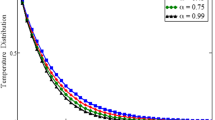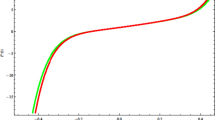Abstract
We test an extended continuum-based approach for analyzing micro-scale gas flows over a wide range of Knudsen number and Mach number. In this approach, additional terms are invoked in the constitutive relations of Navier–Stokes–Fourier equations, which originate from the considerations of phoretic motion as triggered by strong local gradients of density and/or temperature. Such augmented considerations are shown to implicitly take care of the complexities in the flow physics in a thermo-physically consistent sense, so that no special boundary treatment becomes necessary to address phenomenon such as Knudsen paradox. The transition regime gas flows, which are otherwise to be addressed through computationally intensive molecular simulations, become well tractable within the extended quasi-continuum framework without necessitating the use of any fitting parameters. Rigorous comparisons with direct simulation Monte Carlo (DSMC) computations and experimental results support this conjecture for cases of isothermal pressure driven gas flows and high Mach number shock wave flows through rectangular microchannels.








Similar content being viewed by others
References
Anderson DA, Tannehill JC, Pletcher RH (1984) Computational fluid mechanics and heat transfer. Mcgraw-Hill, New York
Arkilic EB, Schmidt MA, Breuer KS (1997) Gaseous slip flow in long microchannels. J Micro Electro Mech Syst 6(2):167–178
Beskok A, Karniadakis GE (1999) A model for flows in channels, pipes, and ducts at micro and nano scales. Microscale Thermophys Eng 3:43–77
Bird GA (1986) Definition of mean free path for real gases. Phys Fluids 26:3222–3223
Bird GA (1994) Molecular gas dynamics and the direct simulation of gas flows. Oxford University Press, New York
Bird RB, Stewart WE, Lightfoot EN (1960) Transport phenomena. Wiley (WIE), New York
Brenner H (2005) Navier–Stokes revisited. Physica A 349:60–132
Brenner H, Bielenberg JR (2005) Continuum approach to phoretic motions: thermophoresis. Physica A 355:251–273
Cercignani C, Lampis M, Lorenzani S (2004) Variational approach to gas flows in microchannels. Phys Fluids 16:3426
Chakraborty S, Durst F (2007) Derivations of extended Navier–Stokes equations from upscaled molecular transport considerations for compressible ideal gas flow: towards extended constitutive forms. Phys Fluids 19(088104):1–4
Dadzie SK, Reese JM, McInnes CR (2008) A continuum model of gas flows with localized density variations. Physica A 387:6079–6094
Dongari N, Agrawal A, Agrawal A (2007) Analytical solution of gaseous slip flow in long microchannels. Int J Heat Mass Transf 50:3411–3421
Dongari N, Sharma A, Durst F (2009) Pressure-driven diffusive gas flows in micro-channels: from the Knudsen to the continuum regimes. Microfluid Nanofluid 6(5):679–692
Eu C (2008) Molecular theory of barycentric velocity: monatomic fluids. J Chem Phys 128:204507
Ewart T, Perrier P, Graur IA, Melonas JB (2007) Mass flow rate measurements in a microchannel, from hydrodynamic to near free molecular regimes. J Fluid Mech 584:337–356
Fang YC, Liou WW (2001) Computations of the flow and heat transfer in microdevices using DSMC with implicit boundary conditions. J Heat Transf 124:338–345
Gaede W (1913) Die Aussere Reibung der Gase. Annalen der Physik 41:289
Greenshields C, Reese JM (2007) The structure of shock waves as a test of Brenner’s modifications to the Navier–Stokes equations. J Fluid Mech 580:407–429
Gu X-J, Emerson DR (2009) A high-order moment approach for capturing non-equilibrium phenomena in the transition regime. J Fluid Mech 636:177–226
Harley JC, Huang Y, Bau HH, Zemel JN (1995) Gas flow in micro-channels. J Fluid Mech 284:257–274
Kaburaki H, Yokokawa M (1994) Computer simulation of two-dimensional continuum flows by the direct simulation Monte Carlo method. Mol Simul 12:441–444
Karniadakis GE, Beskok A, Aluru N (2005) Microflows—fundamentals and simulations. Springer-Verlag, New York
Kennard EH (1938) Kinetic theory of gases with an introduction to statistical mechanics. McGraw-Hill, New York
Knudsen M (1909) Die Gesetze der Molekularströmung und der inneren Reibungsströmung der Gase durch Röhren. Annalen der Physik 28:75–130
Koura KA (1990) Sensitive test for accuracy in the evaluation of molecular collision number in the direct-simulation Monte Carlo method. Phys Fluids A 2(7):1287–1289
Landau LD, Lifshitz EM (1958) Fluid mechanics. Pergamon, Oxford
Liou WW, Fang YC (2001) Heat transfer in microchannel devices using DSMC. J Microelectromech Syst 10:274–279
Lockerby DA, Reese JM (2008) On the modelling of isothermal gas flows at the microscale. J Fluid Mech 604:235
Loyalka SK (1975) Kinetic theory of thermal transpiration and mechanocaloric effect. II. J Chem Phys 63(9):4054–4060
MacCormack RW (1971) numerical solution of the interaction of a shock wave with a laminar boundary layer. Proc. Second Int Conf. Num. Methods Fluid Dyn. Lecture Notes in Physics 8, Springer-Verlag, New York, pp 151–163
Maurer J, Tabeling P, Joseph P, Willaime H (2003) Second-order slip laws in micro-channels for helium and nitrogen. Phys Fluids 15(9):2613–2621
Maxwell JC (1879) On stresses in rarefied gases arising from inequalities of temperature. Philos Trans R Soc 1 170:231–256
Muller I, Ruggeri T (1993) Extended hydrodynamics. Springer, New York
Oh CK, Oran ES, Sinkovits RS (1997) Computations of high speed, high knudsen number microchannel flows. J Thermophys Heat Transf 11:497–505
Öttinger HC (2005) Beyond equilibrium thermodynamics. Wiley, Hoboken, New Jersey
Raju R, Roy S (2003) Hydrodynamic prediction of high speed micro flows. 33rd AIAA Fluid Dynamics Conference and Exhibit, 23–26 June, Orlando, Florida
Sone Y (2002) Kinetic theory and fluid dynamics. Birkhauser, Boston
Sreekanth AK (1969) Slip flow through long circular tubes. In: Trilling L, Wachman HY (eds.) Proceedings of the sixth international symposium on Rarefied Gas Dynamics, Academic Press, pp 667–680
Stops DW (1970) The mean free path of gas molecules in the transition regime. J Phys D Appl Phys 3:685–696
Struchtrup H (2005) Macroscopic transport equations for rarefied gas flows. Springer, Heidelberg
Tannehill JC, Holst TL, Rakich JV (1975) Numerical computation of two-dimensional viscous blunt body flows with an impinging shock, AIAA Paper 75-154, Pasadena, California
Wang M, Li Z (2004) Simulations for gas flows in microgeometries using the direct simulation Monte Carlo method. Int J Heat Fluid Flow 25:975–985
Author information
Authors and Affiliations
Corresponding author
Appendix: Phoretic transport of mass in the framework of extended Navier–Stokes equations
Appendix: Phoretic transport of mass in the framework of extended Navier–Stokes equations
In the traditional derivations of the Navier–Stokes equations, the following assumption of no phoretic transport of mass is implicitly considered:
This suggests that the local density and temperature gradients (or corresponding pressure gradients) do not give rise to any additional transport of mass beyond the advective transport. However, this assumption contradicts the Fourier’s law of diffusive heat transport, given as
This contradiction arises because local temperature gradients, acting as driving forces for heat diffusion, may also lead to phoretic (diffusive) mass flux.
Applying the kinetic theory of gases, the rate of molecular transport of mass may be given by (Bird et al. 1960): \( \dot{m}_{i}^{ + } = 1/6\rho \bar{u}_{x} \) in the positive x i -direction and \( \dot{m}_{x}^{ - } = - {1 \mathord{\left/ {\vphantom {1 6}} \right. \kern-\nulldelimiterspace} 6}\rho \bar{u}_{x} \) in the negative x i -direction, yielding a diffusive mean mass flux \( \dot{m}_{i}^{D} = 0 \) if no spatial density and temperature gradients exist in a flow. In the presence of thermodynamic property gradients of the fluid, a net phoretic mass flux results that can be expressed as
where \( \bar{u}_{i} \) is the molecular mean velocity in the i direction, which can be given as
where T is the absolute temperature, k is the Boltzmann constant, m M is the molecular mass, and λ is the molecular mean free path of the considered ideal gas.
Series expansions of the ρ and \( \bar{u}_{i} \) terms in the square brackets of Eq. A3, omitting the terms beyond first-order in λ, yield:
The above equation can be rewritten to yield for the diffusive mass transport in the x i -direction if only those product terms are considered that contain first-order derivatives, and also considering the isotropy of the molecular motion yielding \( \bar{u}_{i} \left( {x_{i} } \right) = \bar{u}_{M} : \)
Taking into account that the diffusion coefficient D can be written as \( D = - {1 \mathord{\left/ {\vphantom {1 {3\left( {\lambda \bar{u}_{M} } \right)}}} \right. \kern-\nulldelimiterspace} {3\left( {\lambda \bar{u}_{M} } \right)}}, \) it follows that:
With the above expressions for \( \dot{m}_{i} , \) the diffusive heat transport results in the following expression for the heat flux:
The corresponding momentum flux, τ ij , reads as follows:
This expression may be rewritten to yield
Considering the equation of state for ideal gases, one may write
As an illustration, for the special cases of isothermal flows one may write
In addition, one would also expect that the phoretic mass flux should be proportional to the gradient of the free energy, which is defined as \( \psi = I + PV - TS; \) I and S being the internal energy and entropy of the system, respectively. Following this definition, one may write:
Using the Gibb’s relation (TdS = dU + PdV), one may express Eq. A14 as given below:
For isothermal flows of ideal gases, thus, one may have
Rights and permissions
About this article
Cite this article
Dongari, N., Durst, F. & Chakraborty, S. Predicting microscale gas flows and rarefaction effects through extended Navier–Stokes–Fourier equations from phoretic transport considerations. Microfluid Nanofluid 9, 831–846 (2010). https://doi.org/10.1007/s10404-010-0604-5
Received:
Accepted:
Published:
Issue Date:
DOI: https://doi.org/10.1007/s10404-010-0604-5




